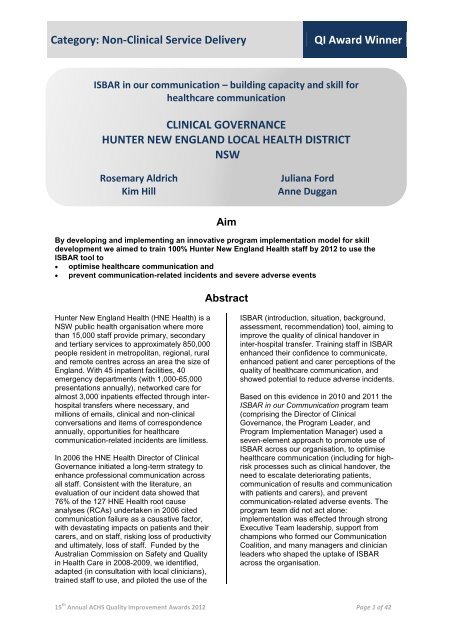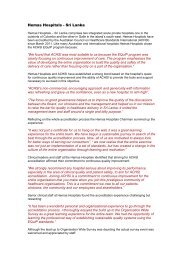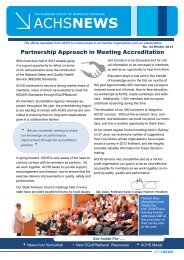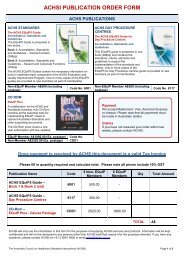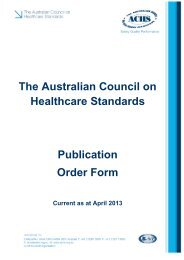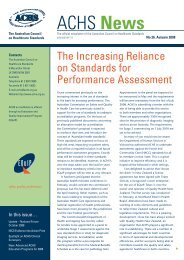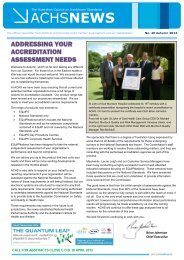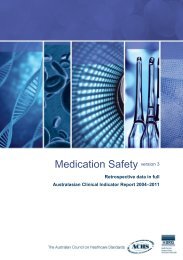Category: Non-Cl<strong>in</strong>ical Service DeliveryQI Award W<strong>in</strong>nerISBAR <strong>in</strong> our communication – build<strong>in</strong>g capacity and skill forhealthcare communicationCLINICAL GOVERNANCEHUNTER NEW ENGLAND LOCAL HEALTH DISTRICTNSWRosemary AldrichKim HillJuliana FordAnne DugganAimBy develop<strong>in</strong>g and implement<strong>in</strong>g an <strong>in</strong>novative program implementation model for skilldevelopment we aimed to tra<strong>in</strong> 100% Hunter New England Health staff by <strong>2012</strong> to use <strong>the</strong>ISBAR tool to optimise healthcare communication and prevent communication-related <strong>in</strong>cidents and severe adverse eventsAbstractHunter New England Health (HNE Health) is aNSW public health organisation where morethan 15,000 staff provide primary, secondaryand tertiary services to approximately 850,000people resident <strong>in</strong> metropolitan, regional, ruraland remote centres across an area <strong>the</strong> size ofEngland. With 45 <strong>in</strong>patient facilities, 40emergency departments (with 1,000-65,000presentations annually), networked care foralmost 3,000 <strong>in</strong>patients effected through <strong>in</strong>terhospitaltransfers where necessary, andmillions of emails, cl<strong>in</strong>ical and non-cl<strong>in</strong>icalconversations and items of correspondenceannually, opportunities for healthcarecommunication-related <strong>in</strong>cidents are limitless.In 2006 <strong>the</strong> HNE Health Director of Cl<strong>in</strong>icalGovernance <strong>in</strong>itiated a long-term strategy toenhance professional communication acrossall staff. Consistent with <strong>the</strong> literature, anevaluation of our <strong>in</strong>cident data showed that76% of <strong>the</strong> 127 HNE Health root causeanalyses (RCAs) undertaken <strong>in</strong> 2006 citedcommunication failure as a causative factor,with devastat<strong>in</strong>g impacts on patients and <strong>the</strong>ircarers, and on staff, risk<strong>in</strong>g loss of productivityand ultimately, loss of staff. Funded by <strong>the</strong>Australian Commission on Safety and <strong>Quality</strong><strong>in</strong> Health Care <strong>in</strong> 2008-2009, we identified,adapted (<strong>in</strong> consultation with local cl<strong>in</strong>icians),tra<strong>in</strong>ed staff to use, and piloted <strong>the</strong> use of <strong>the</strong>ISBAR (<strong>in</strong>troduction, situation, background,assessment, recommendation) tool, aim<strong>in</strong>g toimprove <strong>the</strong> quality of cl<strong>in</strong>ical handover <strong>in</strong><strong>in</strong>ter-hospital transfer. Tra<strong>in</strong><strong>in</strong>g staff <strong>in</strong> ISBARenhanced <strong>the</strong>ir confidence to communicate,enhanced patient and carer perceptions of <strong>the</strong>quality of healthcare communication, andshowed potential to reduce adverse <strong>in</strong>cidents.Based on this evidence <strong>in</strong> 2010 and 2011 <strong>the</strong>ISBAR <strong>in</strong> our Communication program team(compris<strong>in</strong>g <strong>the</strong> Director of Cl<strong>in</strong>icalGovernance, <strong>the</strong> Program Leader, andProgram Implementation Manager) used aseven-element approach to promote use ofISBAR across our organisation, to optimisehealthcare communication (<strong>in</strong>clud<strong>in</strong>g for highriskprocesses such as cl<strong>in</strong>ical handover, <strong>the</strong>need to escalate deteriorat<strong>in</strong>g patients,communication of results and communicationwith patients and carers), and preventcommunication-related adverse events. Theprogram team did not act alone:implementation was effected through strongExecutive Team leadership, support fromchampions who formed our CommunicationCoalition, and many managers and cl<strong>in</strong>icianleaders who shaped <strong>the</strong> uptake of ISBARacross <strong>the</strong> organisation.15 th <strong>Annual</strong> <strong>ACHS</strong> <strong>Quality</strong> Improvement <strong>Awards</strong> <strong>2012</strong> Page 1 of 42
Category: Non-Cl<strong>in</strong>ical Service DeliveryQI Award W<strong>in</strong>nerSimultaneous attention to Leadership andgovernance, Engag<strong>in</strong>g with people andprocesses, Tra<strong>in</strong><strong>in</strong>g and education, Tools andresources, Evaluation and audit, Report<strong>in</strong>gand communication, and Susta<strong>in</strong>ability (ourLETTERS model) resulted <strong>in</strong> more than 9,200staff documented as hav<strong>in</strong>g tra<strong>in</strong>ed to useISBAR <strong>in</strong> <strong>the</strong> year to end November 2011, atwhich time <strong>the</strong> Cl<strong>in</strong>ical Governance ISBARImplementation Manager concluded <strong>the</strong>ir role.The number of staff documented as tra<strong>in</strong>ed <strong>in</strong><strong>the</strong> previous year had <strong>in</strong>creased to nearly10,000 by April <strong>2012</strong>.Our challenge was to educate an entireworkforce to address a critical skill gap,and promote a workplace culture valu<strong>in</strong>gquality communication. A deliberate and broadstrategy for susta<strong>in</strong><strong>in</strong>g staff tra<strong>in</strong><strong>in</strong>g andembedd<strong>in</strong>g use of ISBAR (<strong>in</strong>clud<strong>in</strong>g mak<strong>in</strong>gannual tra<strong>in</strong><strong>in</strong>g mandatory, hav<strong>in</strong>g an e-learn<strong>in</strong>g module, tra<strong>in</strong><strong>in</strong>g 400 managers andsupervisors as tra<strong>in</strong>ers, and hav<strong>in</strong>g an ISBARemail icon on every desktop) has turnedISBAR <strong>in</strong>to a noun and a verb <strong>in</strong> ourorganisation. The format is used widely <strong>in</strong>many sett<strong>in</strong>gs and forms of communication,and for record<strong>in</strong>g <strong>in</strong>formation, which <strong>in</strong> turnhas <strong>in</strong>formed o<strong>the</strong>r quality activities. And <strong>the</strong>rehave been outcomes for patient safety: us<strong>in</strong>gour orig<strong>in</strong>al methods for <strong>in</strong>cident evaluation,and compared with 2006 data, <strong>in</strong> 2011 weobserved a 75% reduction <strong>in</strong> <strong>the</strong> number ofreported healthcare <strong>in</strong>cidents concern<strong>in</strong>gcommunication failure, a 50% reduction <strong>in</strong> <strong>the</strong>proportion of severe adverse events whichimplicated communication-failure as a rootcause (from 76% to 38%), and a 75%reduction <strong>in</strong> <strong>the</strong> absolute number (from 96 to23). Reductions <strong>in</strong> <strong>the</strong> number and severity ofadverse events have resulted from a range of<strong>in</strong>itiatives <strong>in</strong> our organisation, of which <strong>the</strong>ISBAR <strong>in</strong> our Communication program is one.Application of EQuIP Pr<strong>in</strong>ciplesEQuIP pr<strong>in</strong>ciple 1.A Consumer / Patient FocusCommunication failure can have catastrophicconsequences for patients and <strong>the</strong>ir carers(and staff), and it was to address adverseevents as a result of communication failurethat <strong>the</strong> communication strategy was <strong>in</strong>itiated<strong>in</strong> 2006 by <strong>the</strong> Director of Cl<strong>in</strong>ical Governance.Informed by a pilot evaluation of causes andtypes of communication-related adverseevents and compla<strong>in</strong>ts, <strong>in</strong> 2008-2009 weidentified, adapted and tra<strong>in</strong>ed staff to use <strong>the</strong>standard ISBAR format, and evaluated <strong>the</strong>communication experiences of patients and<strong>the</strong>ir carers before and after staff were tra<strong>in</strong>ed(after which patients and carers rated <strong>the</strong>quality of <strong>the</strong>ir communication more highly,and documentation for care showedimprovement). By build<strong>in</strong>g on this evidence -derived from <strong>in</strong>terview<strong>in</strong>g patients and carersabout <strong>the</strong>ir experience of healthcarecommunication - <strong>the</strong> ISBAR <strong>in</strong> ourCommunication strategy 2010-2011 was ableto deliver improved safety outcomes forconsumers and patients.Us<strong>in</strong>g our orig<strong>in</strong>al methods for <strong>in</strong>cidentevaluation, and compared with 2006 data, <strong>in</strong>2011 <strong>the</strong>re was a 50% reduction <strong>in</strong> <strong>the</strong>proportion of severe adverse events for whichcommunication failure was a root cause (from76% to 38%). Given <strong>the</strong> reduction <strong>in</strong> <strong>the</strong>number of severe adverse events over thattime this meant a reduction by 75% <strong>in</strong> <strong>the</strong>absolute number of severe adverse eventsrelated to communication-failure. That <strong>the</strong>rewas no reduction <strong>in</strong> number of compla<strong>in</strong>tsbetween 2006 (308) and 2011 (389) aboutaspects of communication, however,demonstrates we still have work to do toimprove <strong>the</strong> quality of healthcarecommunication with our patients and carers.We recognise that <strong>the</strong> potential exists toempower our consumers to be heard anddemand <strong>the</strong> <strong>in</strong>formation <strong>the</strong>y seek bydevelop<strong>in</strong>g consumer knowledge of <strong>the</strong> ISBARformat.EQuIP pr<strong>in</strong>ciple 2.Effective LeadershipIn response to evidence of effectiveness oftra<strong>in</strong><strong>in</strong>g staff <strong>in</strong> ISBAR, <strong>in</strong> late 2009 <strong>the</strong> <strong>the</strong>nArea Executive Team supported <strong>the</strong>organisation-wide roll-out of <strong>the</strong> program bydedicat<strong>in</strong>g resources for a 1FTEimplementation manager position. Cl<strong>in</strong>icalGovernance had devoted <strong>the</strong> time andexpertise of <strong>the</strong> Director of Cl<strong>in</strong>icalGovernance, as Executive Sponsor, and of <strong>the</strong>Program Leader (an Associate Director ofCl<strong>in</strong>ical Governance) to <strong>the</strong> program and itspredecessor program (approximately 8 hoursper week) s<strong>in</strong>ce 2008.Page 2 of 42 15 th <strong>Annual</strong> <strong>ACHS</strong> <strong>Quality</strong> Improvement <strong>Awards</strong> <strong>2012</strong>


